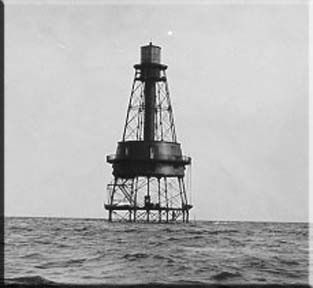
This lighthouse is located approximately six nautical miles east of Key Largo, Florida. The lighthouse has an iron screw-pile foundation with a platform, and a skeletal, octagonal, pyramidal tower, which is painted red. The light is 100 feet (30 m) above the water. It is the oldest functioning lighthouse of its type in the United States, completed in 1852. The lighthouse is named for HMS Carysfort (1766), a 20-gun Royal Navy post ship that ran aground on the reef in 1770. The light is currently a xenon flashtube beacon.
Caesar and Florida
The original light was a lightship named Caesar starting in 1825. Caesar was built in New York City. While being sailed to its station, it went aground near Key Biscayne during a storm, and its crew abandoned the ship. The ship was salvaged by wreckers and taken to Key West, Florida. The owners bought the ship back and it was placed on station at Carysfort Reef. The lightship was often blown off-station by storms, and even went aground on the reef at one point. That first lightship had to be replaced after only five years because of dry rot.
The second lightship was named Florida.
New Lighthouse
Congress appropriated funds for a lighthouse at Carysfort Reef in the 1840s. It was the third screw-pile lighthouse in the United States. The interchangeable parts were manufactured in 1848 in Philadelphia, Pennsylvania, and a construction crew was trained there. The erection of the lighthouse was more difficult than expected. The site was under four-and-a-half feet of water, and the reef was not solid, as expected, but consisted of a hard shell over compacted sand. The plans had to be modified by adding large plates to the piles to spread the weight of the lighthouse over a larger area of the reef. When the supervisor of the construction died, the US Army Corps of Topographical Engineers sent Lieutenant George Meade (later commander of the Army of the Potomac and victor at Gettysburg) to complete the project. This was Meade's first command of a lighthouse project.
Original Structure
The original lens was a first-order Fresnel lens. The structure originally had a balcony that encircled the enclosed, circular light keeper's quarters. The balcony and its railing were later removed.
Year first constructed: 1825 (lightships)
Year first lit: 1852
Automated: 1960
Foundation: screw-pile
Construction: iron
Tower shape: skeletal octagonal pyramid
Height: 120 feet (37 m)
Focal height: 100 feet (30 m)
Original lens: first order Fresnel lens
Range: White 15 nautical miles (28 km; 17 mi), Red 13 nautical miles (24 km; 15 mi)
Characteristic: Flashing white (3) 60s with red sectors
In order to get the correct coordinates, please choose which lighthouse this is:
A) Tennessee Reef Lighthouse - N29° 22.278 W81° 47.286
B) Carysfort Reef Lighthouse - N29° 20.391 W81° 47.939
C) Northwest Passage Lighthouse - N29° 21.768 W81° 47.386
To learn more about Florida Lighthouses, please visit the link below:
Lighthouse Friends, Florida Lighthouses: http://www.lighthousefriends.com/fl.html
Unless noted otherwise, all source material is from Wikipedia.